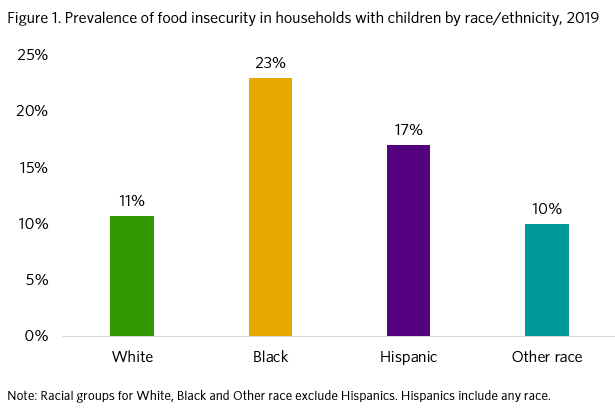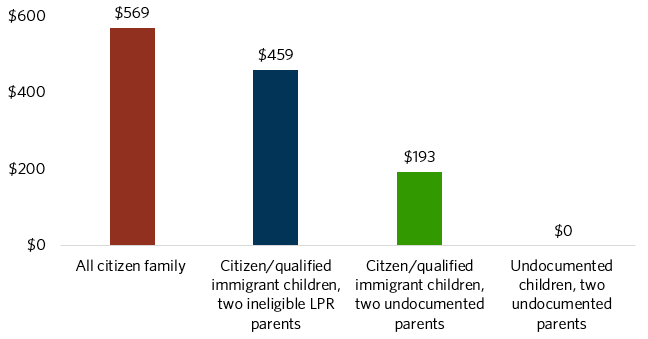The Biden administration recently announced the largest permanent increase in Supplemental Nutrition Assistance Program (SNAP) benefits in the program’s history, but if left unchanged, existing rules mean that millions of children living in immigrant families (most of whom are Hispanic) will benefit less from this increase. A few changes to SNAP eligibility requirements can go a long way to ensuring that we invest equitably in all our children.
SNAP is one of the most powerful tools we have to reduce food insecurity and child poverty. Households are considered “food insecure” if they were at times unable to acquire adequate foods because they had insufficient money. These households may have disrupted eating patterns or reduced food intake. In 2019, almost 14% of households with children experienced food insecurity. Black and Hispanic households with children have the highest food insecurity rates (23% and 17%, respectively) compared to White and other race households with children (11% and 10%, respectively).
Food insecurity has severe consequences for children and families: Children in food insecure households suffer a wide array of negative health, developmental, and education outcomes. Because SNAP substantially reduces the prevalence and severity of food insecurity, adequate SNAP benefits are critical to reducing the negative effects of food insecurity on children.
Source: Coleman-Jensen, A., Rabbitt, P., Gregory, C.A., Singh, A. (2019). Household Food Security in the United States in 2019 Report No. 275. United States Department of Agriculture Economic Research Service. https://www.ers.usda.gov/webdocs/publications/99282/err-275.pdf?v=5260.9
The increase in SNAP benefits comes from a reevaluation of the Thrifty Food Plan, a list of food groups the government uses to estimate a very low cost and nutritious diet. The total cost of the items in the Thrifty Food Plan is the maximum SNAP benefit for a household. Under the new plan, average SNAP benefits are estimated to rise by $36 a month, per person. This modest increase will help the 42 million (1 in 8) Americans receiving benefits improve their nutrition and reduce food insecurity. However, restrictive immigrant eligibility criteria will disproportionately exclude Hispanic children from this historic benefit increase.
Immigrant eligibility exclusions disproportionately hurt Hispanic children
Hispanic children make up about 25% of the child population, and SNAP eligibility restrictions based on immigration status disproportionately hurt them. Almost all Hispanic children are U.S. citizens (95%), but more than half have at least one foreign-born parent and about a quarter have an undocumented parent. Although their parents have higher employment rates than other adults, they tend to hold low-wage jobs, which, in combination with restricted access to SNAP, puts their families at high risk for food insecurity.
Unlike many other safety net programs, eligibility for SNAP is determined at the child level, which means that, provided they meet income eligibility, U.S. citizen children and lawfully present immigrant children are eligible regardless of the immigration status of other household members. But, these children’s benefits could be hundreds of dollars lower than children in all-citizen families because benefits are prorated—calculated based on the number of eligible members of the family.
Proration excludes ineligible adults such as Legal Permanent Residents who have had qualified status for less than five years (five-year bar) or undocumented immigrants. This proration means that an all-citizen family of four would receive $569 as their monthly SNAP benefit, but a family with two Legal Permanent Resident parents who have not met the five-year bar would receive a reduced benefit of $459. If the parents are undocumented the benefit is even lower at $193. Children who are undocumented immigrants are ineligible for SNAP benefits.
Change SNAP immigrant eligibility to invest in all children
Increasing SNAP benefits can go a long way towards reducing food insecurity. But for the reduction of food insecurity to be equitable, we need to change SNAP immigrant eligibility criteria to include all children in immigrant families. Improving access to SNAP benefits for children in immigrant families is not only the right thing to do, it also makes sense. In the short term, it helps equitably provide a nutritious diet to some of our most vulnerable children. In the long term, an investment in all children, including those living in immigrant families, is an investment in future American workers and citizens.
To achieve these goals, leaders have a spectrum of policy options. At a minimum, the government could eliminate the proration of SNAP benefits. This rule punishes eligible children just for living in a household with ineligible immigrants. The government could also eliminate the five-year bar for qualified immigrant adults. The five-year bar exacerbates financial hardship for immigrant families, including citizen children. The most inclusive policy option is to restore immigrant SNAP eligibility to their levels when the program was first introduced in the 1960s: benefits were available to all noncitizens regardless of immigration status.
This historic increase in SNAP benefits is an important investment in reducing food insecurity. But without addressing the exclusions that target immigrant families, it further entrenches racial and ethnic inequities. To fairly and justly cut food insecurity for children we must deliberately choose to include children and their families in the SNAP program, regardless of immigration status.
More about the exclusion of children in immigrant families from the U.S. safety net
Restoring an Inclusionary Safety Net for Children in Immigrant Families, in Health Affairs
The Overlooked Children, Heller Magazine features ICYFP research







